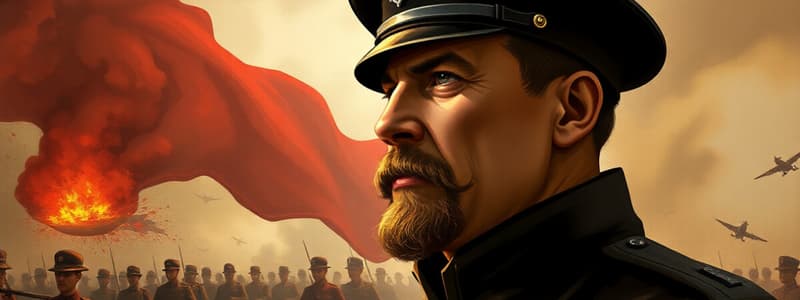Podcast
Questions and Answers
Which of the following best describes the strategic impact of trench warfare during World War I?
Which of the following best describes the strategic impact of trench warfare during World War I?
- It frequently led to stalemates and prolonged periods of attrition. (correct)
- It minimized casualties and allowed for quick, decisive victories.
- It facilitated rapid territorial gains for the attacking side.
- It enabled effective flanking maneuvers, leading to breakthroughs.
How did the Zimmerman Telegram influence the United States' decision to enter World War I?
How did the Zimmerman Telegram influence the United States' decision to enter World War I?
- It revealed a secret agreement between Germany and Russia to divide Europe.
- It outlined a strategy for German U-boats to avoid attacking American ships.
- It proposed a military alliance between Germany and Mexico against the U.S. (correct)
- It detailed plans for a joint invasion of Britain.
How did the sinking of the Lusitania impact public opinion in the United States during World War I?
How did the sinking of the Lusitania impact public opinion in the United States during World War I?
- It led to widespread support for immediate U.S. entry into the war.
- It had little impact, as the ship was primarily carrying military supplies.
- It increased anti-German sentiment and put pressure on the U.S. government to take action. (correct)
- It caused the U.S. to implement stricter neutrality policies to avoid further incidents.
Which of the following factors contributed most significantly to the outbreak of World War I?
Which of the following factors contributed most significantly to the outbreak of World War I?
What was the main objective of the Selective Service Act during World War I?
What was the main objective of the Selective Service Act during World War I?
How did U-boats change the nature of naval warfare during World War I?
How did U-boats change the nature of naval warfare during World War I?
What was the primary goal of the Treaty of Versailles?
What was the primary goal of the Treaty of Versailles?
What role did nationalism play in the events leading up to World War I?
What role did nationalism play in the events leading up to World War I?
How did Henry Cabot Lodge influence the United States' decision regarding the Treaty of Versailles and the League of Nations?
How did Henry Cabot Lodge influence the United States' decision regarding the Treaty of Versailles and the League of Nations?
What was the significance of Liberty Bonds during World War I?
What was the significance of Liberty Bonds during World War I?
Flashcards
Militarism
Militarism
Aggressive strengthening of armed forces.
Archduke Franz Ferdinand
Archduke Franz Ferdinand
Heir of Austria-Hungary whose assassination triggered World War I.
Central Powers
Central Powers
Austria-Hungary, Germany, Bulgaria and Ottoman Empire.
Allied Powers
Allied Powers
Signup and view all the flashcards
Trench Warfare
Trench Warfare
Signup and view all the flashcards
U-boats
U-boats
Signup and view all the flashcards
Nationalism
Nationalism
Signup and view all the flashcards
Selective Service Act
Selective Service Act
Signup and view all the flashcards
Reparations
Reparations
Signup and view all the flashcards
Treaty of Versailles
Treaty of Versailles
Signup and view all the flashcards
Study Notes
- Militarism refers to the aggressive strengthening of armed forces.
- Archduke Franz Ferdinand, the heir to Austria-Hungary, was assassinated by Serbian nationalists, an event that triggered World War I.
- The Central Powers included Austria-Hungary, Germany, Bulgaria, and the Ottoman Empire.
- The Allied Powers consisted of the USA, France, Russia, and Italy.
- Trench Warfare was an ineffective method of fighting that involved troops occupying trenches.
- U-boats were German submarines used in the war.
- Nationalism is a strong feeling of loyalty to one's country.
- World War I technology included submarines, airplanes, machine guns, poison gases, trenches, and tanks.
- Lusitania was a British passenger ship sunk by German U-boats.
- The Zimmerman Telegram, sent by Germany to Mexico, proposed an alliance and contributed to the U.S. decision to enter the war. It is also known as the Zimmerman Note.
- The Selective Service Act drafted men between the ages of 21 and 30 into the army.
- An armistice is a truce or agreement to stop fighting.
- The costs of World War I included casualties, financial losses, and a flu pandemic.
- The Peace Agreement involved Wilson's 14 points, the League of Nations, and the Treaty of Versailles.
- The Treaty of Versailles was the final peace settlement of World War I.
- Communists advocate for equal distribution of wealth and the abolition of private property.
- Stalemate describes a situation in which neither side can achieve a decisive victory.
- Mobilized means to prepare the military for war.
- Reparations are payments made for war damages.
- Henry Cabot Lodge was a senator who led Republican opposition to the ratification of the Treaty of Versailles.
- Liberty Bonds were issued to raise billions of dollars for the Allies' war efforts.
- The American Expeditionary Force was the name for U.S. troops sent to Europe during World War I.
Studying That Suits You
Use AI to generate personalized quizzes and flashcards to suit your learning preferences.




